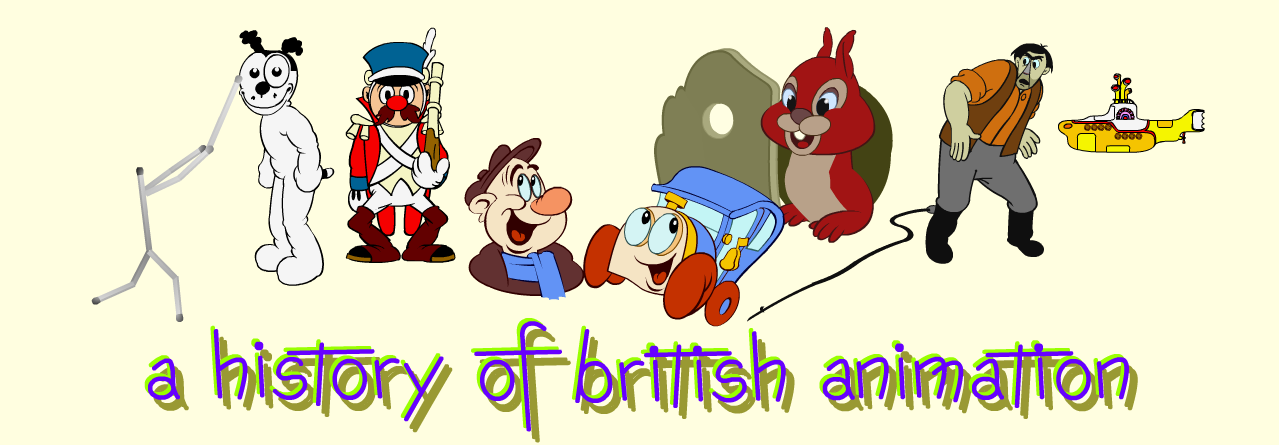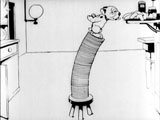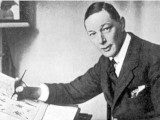

|
 | G E Studdy(1878-1948) |  |
||
|
George Ernest Studdy was born in Devonport on 23 June 1878, the second child of Ernest Studdy, a lieutenant in the Argyll and Sutherland Highlanders, and his wife Constance. George's siblings were an elder sister and younger brother. George shared his father's love of outdoor pursuits, especially fishing, but the expectation that he would follow an army career was dashed when a pitchfork accident seriously injured his foot. Moving to London for specialist treatment he stayed with his aunt in Dulwich and was educated at Dulwich College. He left school in 1986: a short apprenticeship as an engineer was followed by three years with a firm of stockbrokers, but these were not careers that suited George. With help from his aunt he attended evening classes at Heatherley's School of Art, and spent a term at Calderon's School of Animal Painting. Sharing a studio with some fellow students, George was soon selling illustrations to newspapers and magazines. By 1902 he was specialising in humerous drawings for comic magazines and had begun to sell work to the postcard publisher Valentine. In June 1912 George Studdy married Paris-born Blanche Ernestine Landrin. By this time his work was appearing in The Bystander and The Tatler and he was providing a regular full-page panel for the weekly magazine The Sketch. His injured foot made him ineligible for army service at the outbreak of the First World War. In the cinema the 'lightning artist' film format was being revived to feature propaganda sketches. It proved very popular and in late 1914 Gaumont hired Studdy to draw cartoons for them. The resultant sequences were packaged in sets of five and released as Studdy's War Studies on 28 December 1914 and 15 and 25 February 1915. A trade advertisement describes them as: 450 FEET OF LAUGHTER. FULL OF FUN. FIVE GOOD SECTIONS. DELIGHTFUL CARICATURES. THE BEST OF ALL WAR CARTOONS. After three War Studies releases Gaumont ended the package series and instead included a single cartoon sequence in its Gaumont Graphic newsreel releases from April to July. Initially consisting of speeded-up photography of Studdy's hand inking the image, the sequences soon adopted the animated 'drawing-on' technique being used by other 'War cartoon' series. It is unclear whether this was to free up Studdy from laborious involvement in the shooting process (having provided the finished cartoon Studdy could leave another artist to do the under-the-camera work) or just to keep up with the competition, with Studdy still intimately involved in the process. To 'draw on' the cartoon, Studdy created the image of a diminutive artist called 'IT' who wields a large (or rather, normal-sized) paint brush. Because the animation camera looked vertically down onto a horizontal table where the artwork was laid out, Studdy drew the figure as seen from above, as he did for an animated sequence called Frightfulness V. Fair-Play where a demon and a bulldog fight, the bulldog gradually tearing the demon to pieces. While in the case of Frightfulness V. Fair-Play this down view is immediately recognisable — it recalls the view into a fighting pit — it does not really work so well with 'IT'. The average viewer would have no idea of the set-up of the animation camera and would be used to seeing an artist working in an upright fashion at a canvas or drawing block supported on an easel, so the down view on 'IT' appears somewhat odd. The technique used was cut-out animation, the quickest way of producing animated movement. The animation is fairly simple — 'IT' shuffles his feet about but they don't contribute to the swift movement around the canvas as he 'draws' the image. Likewise, 'Frightfulness' and 'Fair-Play' circle round each other with the bulldog darting in and back as it tears bits off the demon. The dog's legs move about but do not support the body action. With his interest in animal anatomy one might have expected Studdy to be more interested in articulating the body, which tempts me to think he merely designed the image and left someone else to animate it. Certainly the animation in other segments consists, after the 'drawing on' of the image, of simple moving parts — the image of the Kaiser in a diving suit, clutching the Lusitania in his arms, drifts down to settle on the seabed to form the finished cartoon with the added speech balloon "HURRAH! THIS IS LOWER THAN ANY HUMAN BEING HAS EVER SUNK!"; a man watching a thermometer that shows the rising tax on alcohol follows the rising column with his eyes, then the head and arm bump to a brow-mopping pose as the caption "A BIT TOO HOT!" appears. Even in the sequential segment on the spread of germs by flies it is clear that it is ultimately based on the final image — the man swatting the fly remains in the fixed final pose in contrast to the energetic animation of his arm. It seems possible that Studdy was more concerned with creating the finished cartoon image and that someone else separated the parts and did the animation. Studdy continued to produce his weekly cartoon for The Sketch as well as illustrations for other periodicals. In 1912 his Sketch panel had featured some canine situations under the title Studdy's Dog Studies, and in 1921 the editor, Bruce Ingram, urged Studdy to do more dog cartoons, suggesting a six month series. The first, The Ghost Story showing an older dog spinning a yarn to five fearful puppies, appeared on 2nd November 1921 and the series proved popular enough for The Sketch to publish a collection, The Studdy Dogs Portfolio, the following May. The series continued and over time the various dogs featured coalesced into one particular round-faced puppy. On the 8th November 1922 This Week's Studdy was subtitled Bonzo's Latest and the text below read "A large number of readers have shown themselves curious as to the name of the famous Studdy dog. To satisfy them we announce that his name is 'Bonzo'." The name was Bruce Ingram's choice — apparently Studdy did not care for it much. Bonzo's popularity soared, and merchandising followed. By 1923 Study's cartoons were being syndicated in America and Europe, Bonzo storybooks and soft toys were in the shops and Bonzo references were shoehorned into two current West End productions, the musical comedy Battling Butler, where Jack Buchanan sings "Battling Bonzo" to a stuffed toy and the musical revue From Dover Street to Dixie, where Studdy provided a design for the safety curtain illustrating Bonzo en route from England to America. [Despite the claim on several sites, I have found no evidence so far that either show actually featured George Atterbury, the actor who made a career of playing Bonzo in pantomime starting with Aladdin in 1930.] In 1924 animator William A Ward approached Studdy (given his subsequent credit as producer, I presume Ward to be the initiator of the project) with the idea of a series of animated Bonzo cartoons to rival the newly-imported Felix the Cat. The distributor New Era Films financed the series and provided studio space. A team of artists was recruited to work on the series which eschewed cut-out animation in favour of the sequential drawings method as developed in America, where the animation was inked on sheets of paper and background details and static items were inked on sheets of celluloid. A trade advertisement from October 1924, announcing the series, concludes: The drawings in themselves are a work of art, and animation never before attempted has been produced to perfection. The scenarios too, which are the work of Mr. Studdy, are the essence of comedy, and the character is without doubt the most humorous and lovable little fellow the screen has ever known. Studdy's scenario contributions, presumably worked out in collaboration with Ward, probably extended to drawings showing the various key scenes, effectively layouts on which the animation would be based. Given the increasing amount of illustration work created by the popularity of Bonzo in addition to his weekly Sketch page, it is unlikely that Studdy was involved in the actual animation process, and his contribution to the scenarios also reduces with time. At some point the live-action director Adrian Brunel, then best known for comedy shorts parodying movie genres, was brought in to help provide scenarios. Initially the stories revolved around Bonzo's primarily canine behaviour, as in the press cartoons, but as the series progressed Bonzo increasingly adopts the generic man-child persona of silent comedy that Felix and other animated characters displayed, interacting with humans on a more equal basis. Occasionally he also uses the kind of surreal gags that Felix was known for, particularly in Zoo-ology where he uses the spot off his back as a ball, and the letters of the ZOO sign to make a bicycle. Presumably once they had demonstrated their competence Studdy was happy to leave the animation team to their own devices, but he seems to have remained involved with the studio. When production on the series ended, as animator Brian White relates: Most of the staff dispersed to leave the film world for good. Studdy, Ward, the camera man Pat Tobin and myself remained for a while as both Studdy and Ward each had hopes of starting a series of their own. New Era were not interested in continuing animation production — despite the popularity of the Bonzo films the returns, both domestic and foreign, were presumably insufficient to justify investment in further animation production. Studdy continued producing Bonzo illustrations for The Sketch, Valentine postcards and various advertisers. In 1927 The Sketch decided to give Bonzo a rest and Studdy provided them with a series depicting "What We Motorists All Feel At Times!". Later he created a series featuring a cat called Ooloo, but Ooloo never achieved Bonzo's level of popularity. The success of Bonzo made Studdy a wealthy man, but after purchasing a home for his family and making a few investments he used most of his income to support various charities and good causes. The failure of some of the investments meant he needed to keep working, and towards the end of the 1930s he took on additional work with a series of 'seaside' postcards of the 'Donald McGill' style. These he signed with the pseudonym Cheero, feeling they were rather beneath his dignity. During WWII Studdy worked as a draughtsman at the Royal Naval Dockyards, Portsmouth, while his wife and daughter left London for the Lake District. The London house suffered badly from bomb damage, but the family returned there when it was rebuilt after the War. Studdy returned to his illustrating work, but by the end of 1947 chest pains had been diagnosed as cancer. He became confined to bed and died on 25 July 1948.
|
Filmography | ||||
| Studdy's War Studies No. 1 | (Gaumont, released 28 Dec 1914) Designer, (Animator?) | |||
| Studdy's War Studies No. 2 | (Gaumont, released 15 Feb 1915) Designer, (Animator?) | |||
| Studdy's War Studies No. 3 | (Gaumont, released 25 Feb 1915) Designer, (Animator?) | |||
| Studdy's War Studies: The Emigrant | (Gaumont Graphic No. 421, Mar 1915) Designer, (Animator?) | |||
| Studdy's War Cartoon: A Spring Tonic | (Gaumont Graphic No. 425, 19 Apr 1915) Designer, (Animator?) | |||
| Studdy's War Cartoon: His Winning Ways | (Gaumont Graphic No. 427, 26 Apr 1915) Designer, (Animator?) | |||
| Studdy's War Cartoon: A Fight to the Finish | (Gaumont Graphic No. 429, 03 May 1915) Designer, (Animator?) | |||
| Studdy's War Cartoon: Convalescent | (Gaumont Graphic No. 431, 10 May 1915) Designer, (Animator?) | |||
| Studdy's War Cartoon: The Record Breaker | (Gaumont Graphic No. 433, 17 May 1915) Designer, (Animator?) | |||
| Studdy's War Cartoon: The Little Zeppelin | (Gaumont Graphic No. 450, 15 Jul 1915) Designer, (Animator?) | |||
| Studdy's War Cartoon: A Sea of Crime | (Gaumont Graphic 1915, not released?) Designer, (Animator?) | |||
| Studdy's War Cartoon: Money Talks | (Gaumont Graphic 1915, not released?) Designer, (Animator?) | |||
| Bonzo (series of 26 films) | (NewEra Films 1924-5) Creator/Designer, some Scenarios | |||
Links to Other Sites | ||||
BFI Player Studdy's War Cartoons: a compilation of clips from the Gaumont Graphic series. | ||||
George Studdy and Bonzo the Dog: Richard Fitzpatrick's informative website, includion biography and a rich archive of published illustrations. | ||||
BFI Player Bonzo: Video of the first Bonzo film. | ||||
BFI Player Bonzo No. 5: Video of the fifth Bonzo film. | ||||
YouTube Bonzo in Tanked: US release of Bonzo in the Army, transferred with added soundtrack by Tom Stathes. | ||||
YouTube Bonzo the Pup in Dog-Gone: US super-8 cutdown from Zoo-Ology or Bonzo at the Zoo. |
Peter Hale
Last updated 2019
|